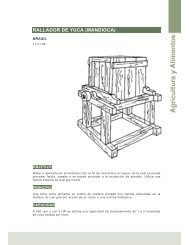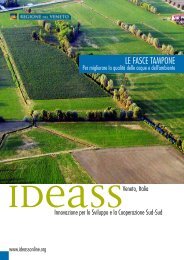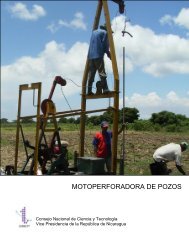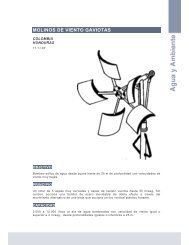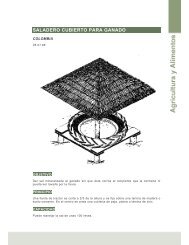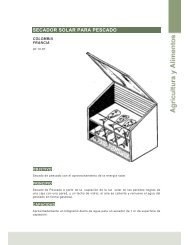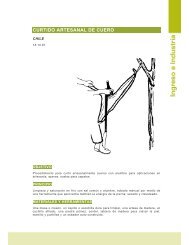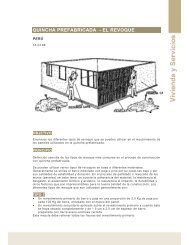Diseño y construcción de plantas de biogás ... - Ideassonline.org
Diseño y construcción de plantas de biogás ... - Ideassonline.org
Diseño y construcción de plantas de biogás ... - Ideassonline.org
- No tags were found...
Create successful ePaper yourself
Turn your PDF publications into a flip-book with our unique Google optimized e-Paper software.
22 DISEÑO Y CONSTRUCCIÓN DE PLANTAS DE BIOGÁS SENCILLAS<br />
TABLA 2.<br />
Índices <strong>de</strong> consumo <strong>de</strong> gas según el tipo <strong>de</strong> cocina y su uso<br />
TIPO DE USO<br />
COCINA COLECTIVA (ALMUERZO). 0,20<br />
COCINA COLECTIVA (ALMUERZO Y CENA) 0,30<br />
COCINA INDIVIDUAL (USO DOMÉSTICO) 0,45<br />
CONSUMIDORES/USUARIO/DÍA<br />
Teóricamente se pue<strong>de</strong> obtener biogás <strong>de</strong> cualquier material <strong>org</strong>ánico.<br />
Este material <strong>org</strong>ánico, o biomasa, <strong>de</strong>be <strong>de</strong> contar con 5-10 %<br />
<strong>de</strong> partes sólidas para constituir un material apropiado, como cieno <strong>de</strong><br />
fermentación.<br />
Una <strong>de</strong> las materias <strong>org</strong>ánicas más utilizadas es el estiércol fresco<br />
<strong>de</strong> ganado vacuno, que contiene alre<strong>de</strong>dor <strong>de</strong> 16 % <strong>de</strong> material sólido<br />
y 84 % <strong>de</strong> agua, y que se recomienda mezclar en proporción 1:1 con<br />
agua. El cieno <strong>de</strong> fermentación para introducir en una planta <strong>de</strong> biogás<br />
tiene entonces 8 % <strong>de</strong> material sólido y 92 % <strong>de</strong> agua.<br />
Algunos índices <strong>de</strong> consumo a partir <strong>de</strong> las biomasas más utilizadas<br />
y disponibles en Cuba para la producción <strong>de</strong> biogás se exponen en<br />
la tabla 3.<br />
TABLA 3.<br />
Índices para <strong>de</strong>terminar la producción <strong>de</strong> biogás<br />
a partir <strong>de</strong>l peso y características <strong>de</strong> la biomasa<br />
EXCRETA HÚMEDA BIOGÁS PROPORCIÓN TIEMPO DE RETENCIÓN<br />
DIARIA (KG/ANIMAL) (M 3 /DÍA) EXCRETA-AGUA ACONSEJABLE (DÍA)<br />
VACA 10 0,360 1:1 40<br />
TORO 15 0,540 1:1 40<br />
CERDO (50 KG) 2,25 0,101 1:1-3 40<br />
POLLO 0,18 0,108 1:1-8 30<br />
CABALLO 10 0,300 1:1-3 30<br />
CARNERO 2 0,100 1:1-3 40<br />
TERNERO 5 0,200 1:1 40<br />
PERSONA ADULTA 0,40 0,025 1:1 60<br />
CACHAZA 0,035 kg/kg 0,100 1:4 30<br />
RESIDUAL DE MATADERO (1 m 3 biogás/25 kg <strong>de</strong> residuos) 40<br />
RESIDUAL DE DESTILERÍA (15 m 3 biogás/m 3 <strong>de</strong> residuos) 40<br />
RESIDUAL DE LEVADURA (4 m 3 biogás/m 3 <strong>de</strong> residuos) 40<br />
LÍQUIDO DEL CAFÉ (5 m 3 biogás/m 3 <strong>de</strong> residuos) 40<br />
CÁSCARA DE CAFÉ (0,1 m 3 biogás/m 3 <strong>de</strong> residuos) 50<br />
CÁSCARA DE CAFÉ (0,4 m 3 biogás/25 kg <strong>de</strong> materia sea) 60<br />
Es necesario subrayar que el estiércol <strong>de</strong> cada lugar tiene sus<br />
características propias <strong>de</strong>bido a la variación <strong>de</strong> la alimentación, manejo<br />
y raza <strong>de</strong> los animales, tiempo <strong>de</strong> estabulación, existencia <strong>de</strong> piso<br />
<strong>de</strong> hormigón en los establos o cochiqueras, etcétera. Todo esto indica



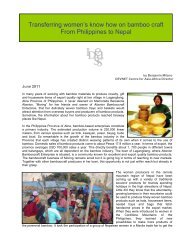
![[M077] Molino de viento cretense-instalación - Ideassonline.org](https://img.yumpu.com/51119608/1/190x245/m077-molino-de-viento-cretense-instalacian-ideassonlineorg.jpg?quality=85)
![[E004] Secador solar para madera (Guatemala ) - Ideassonline.org](https://img.yumpu.com/50176079/1/190x245/e004-secador-solar-para-madera-guatemala-ideassonlineorg.jpg?quality=85)
